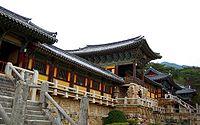- Daegaya
-
Daegaya Hangul 대가야 Hanja 大伽倻 Revised Romanization Daegaya McCune–Reischauer Taegaya History of Korea 
This article is part of a seriesPrehistory Jeulmun period Mumun period Gojoseon ?–108 BCE Wiman Joseon 194 BCE–108 BCE Proto–Three Kingdoms 300–57 BCE Buyeo, Goguryeo, Okjeo, Dongye Jin state, Samhan (Ma, Byeon, Jin) Four Commanderies of Han Three Kingdoms 57 BCE–668 Goguryeo 37 BCE–668 Baekje 18 BCE–660 Silla 57 BCE–935 Gaya 42–562 North and South States 698–926 Unified Silla 668–935 Balhae 698–926 Later Three Kingdoms 892–936 Taebong, Hubaekje, Silla Goryeo Dynasty 918–1392 Joseon Dynasty 1392–1897 Korean Empire 1897–1910 Colonial Korea 1910–1945 Provisional Gov't 1919–1948 Division of Korea 1945–present North, South Korea 1948–present By topic Timeline List of monarchs Linguistic history Science and technology history Art history Military history Naval history
Korea Portal
Daegaya was a city-state in the Gaya confederacy during the Korean Three Kingdoms period. Daegaya was located in present-day Goryeong County, in North Gyeongsang Province of South Korea. (It should not be confused with Goryeong Gaya, which was located around present-day Sangju.)
According to "Geographies" in Samguk Sagi, Daegaya existed for about 520 years from the first king, Ijinashi (이진아시왕), to the last, Doseolji (도설지왕). Daegaya had sixteen kings from King Ininashi to King Doseolji but only five of those are known; the 1st king was Ijinasi, the 9th king Inoe, the 16th king Doseolji, and King Haji, whose generation is uncertain. King Haji (하지, 荷知) sent an embassy to Namje (南齊, the Southern Qi Dynasty) in 479. According to Chinese records, he received a rank of the third order, one rank below Baekje and Silla.
Daegaya developed quickly and played a major role in the Gaya confederacy in the 5th century AD, partly because of its advanced steel-making craft, but its progress and that of the confederacy were limited by the neighboring kingdoms of Baekje and Silla, which were more fully developed as centralized political entities. Incidental historical records and archeological findings indicate a highly stratified aristocratic society in Daegaya and the Gaya confederacy at this time.
King Haji allied with Baekje and Silla to attack Goguryeo in 481 AD. Daegaya allied with Baekje to attack Silla (which, for Baekje, was in response to Silla's breach of their 120-year truce) at the battle of Gwansan Fortress in 554 AD, but both Baekje and Gaya suffered heavy losses. This confrontation policy alienated the other member states of the Gaya confederation, and Daegaya lost its leadership of Gaya to Ara Gaya.
Daegaya fell to the armies of Silla under general Kim Isabu in 562 AD; Silla, having already begun to absorb much of the Gaya confederacy, had invaded Daegaya as punishment for having allied with Baekje in 554.
See also
- List of Korea-related topics
- List of Korean monarchs
- History of Korea
- Gaya confederacy
External links
Categories:- Gaya confederacy
- Former countries in East Asia
- Former countries in Korean history
Wikimedia Foundation. 2010.
